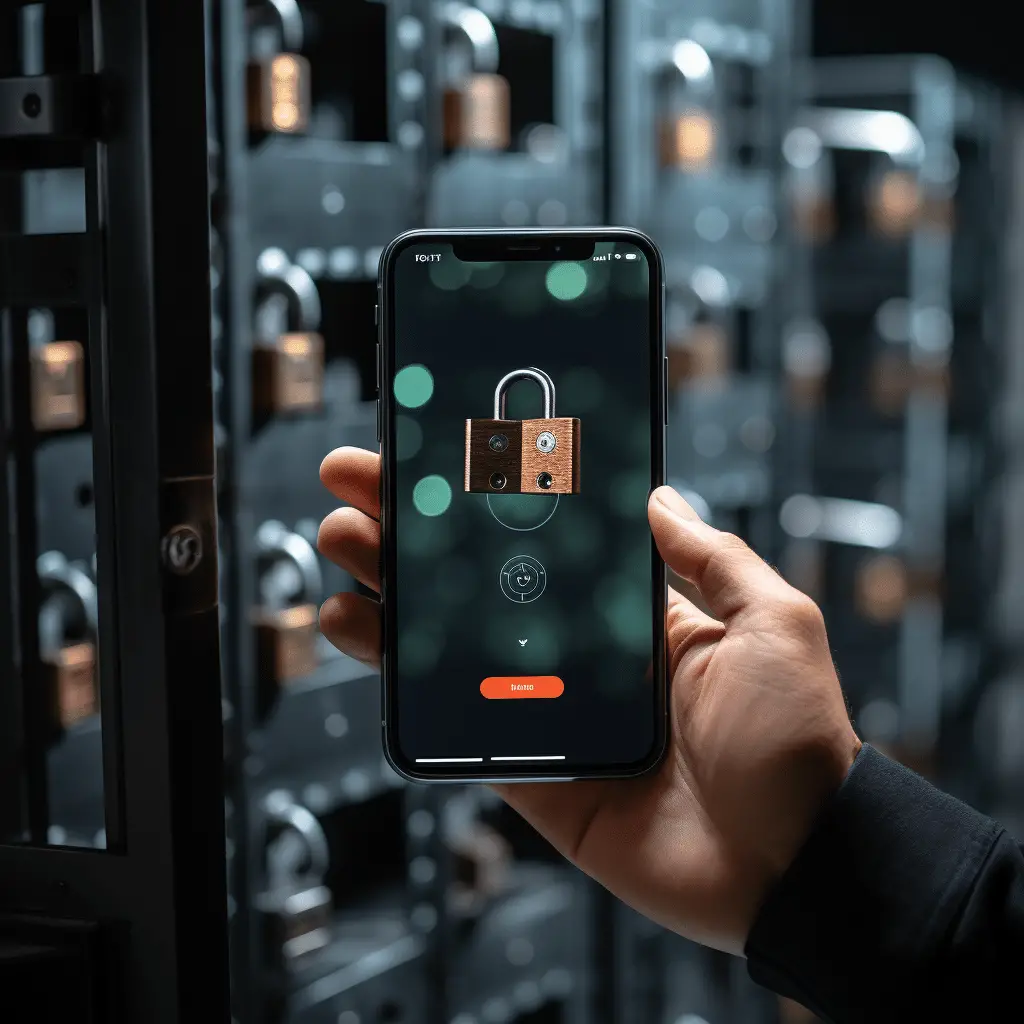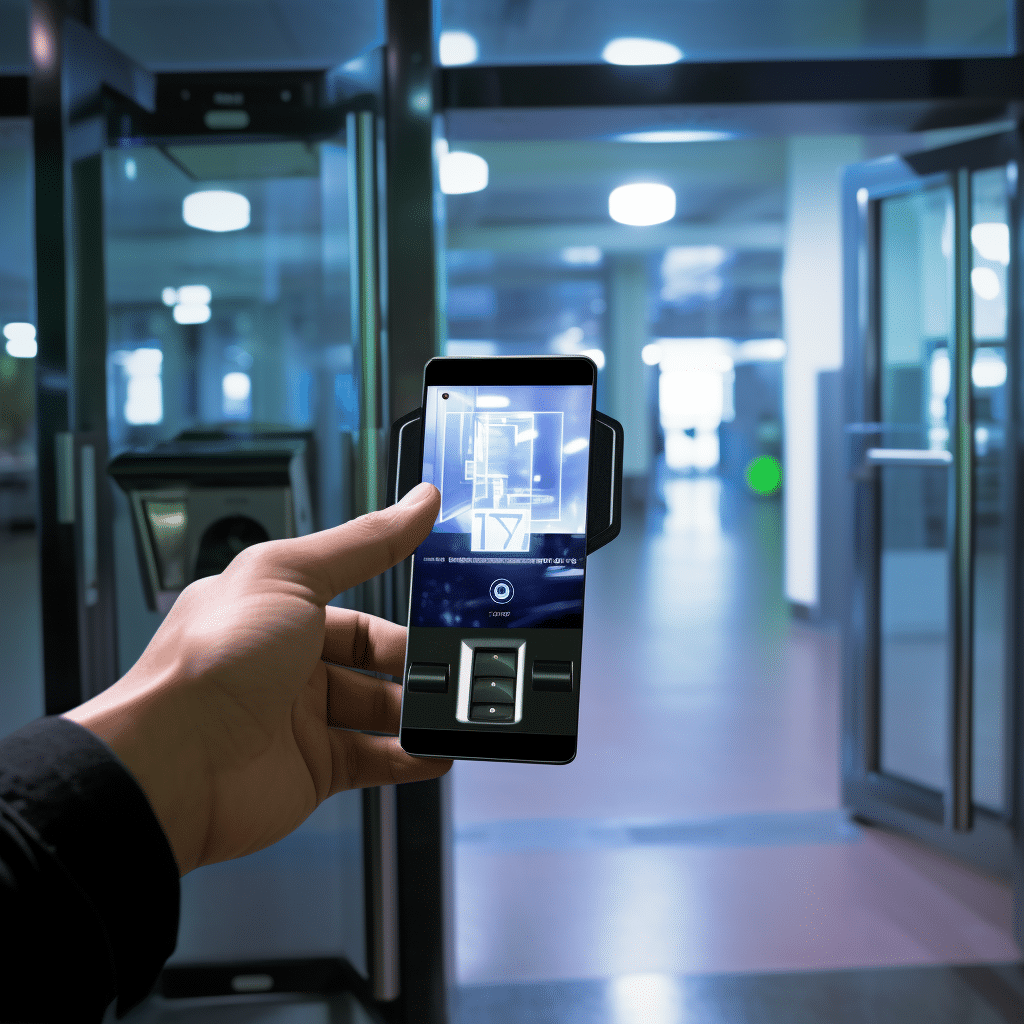Mobile credentials offer a new and advanced approach to access control, revolutionizing the way organizations manage security. With the increasing use of mobile devices and the need for heightened security measures, mobile credentials provide a convenient and secure solution. They allow users to access controlled areas using their smartphones or other mobile devices, eliminating the need for physical cards or key fobs. This not only enhances convenience but also improves safety by reducing the risk of lost or stolen credentials. By implementing mobile credentials for access control, organizations can streamline their security processes while ensuring maximum security.

Key Takeaways:
- Mobile credentials provide a convenient and secure solution for access control.
- Using mobile devices eliminates the need for physical cards or key fobs.
- Mobile credentials enhance convenience and improve safety.
- Implementing mobile credentials streamlines security processes.
- Mobile credentials ensure maximum security for access control systems.
The Importance of Mobile Security in Access Control
Mobile security is a critical aspect of implementing mobile credentials for access control. As organizations increasingly rely on mobile devices for access, ensuring the security of these devices becomes paramount. Without proper security measures in place, mobile credentials can be vulnerable to cyber threats and unauthorized access.
To address these concerns, organizations should prioritize mobile security by implementing encryption protocols, secure authentication methods, and robust identity and access management solutions. By encrypting mobile credentials, organizations can protect sensitive data from being intercepted or compromised. Secure authentication methods, such as biometrics or multi-factor authentication, add an extra layer of protection by verifying the identity of the individual accessing the controlled area.
Mobile security measures protect against threats such as malware, phishing attacks, and data breaches, providing comprehensive security for access control systems.
In addition to encryption and authentication, organizations should also consider implementing secure communication protocols and regularly updating and patching mobile devices. By keeping mobile devices up to date with the latest security patches, organizations can mitigate the risk of vulnerabilities being exploited. Secure communication protocols further ensure that data transmitted between mobile devices and access control systems is protected from interception and tampering.
The Role of Digital Credentials in Mobile Security
Central to mobile security in access control systems is the use of digital credentials. Digital credentials are securely stored on mobile devices and serve as the means of authentication for accessing controlled areas. These credentials can be easily updated or revoked, providing organizations with greater control over access. By leveraging digital credentials and implementing robust security measures, organizations can ensure that only authorized individuals can gain access to sensitive areas or data.
| Mobile Security Best Practices | Description |
|---|---|
| Implement encryption protocols | Protects mobile credentials from being intercepted or compromised |
| Use secure authentication methods | Verifies the identity of individuals accessing controlled areas |
| Regularly update and patch mobile devices | Mitigates the risk of vulnerabilities being exploited |
| Utilize secure communication protocols | Protects data transmitted between mobile devices and access control systems |
| Implement identity and access management solutions | Ensures proper management and control of mobile credentials |
Common Misconfigurations in Mobile Credential Systems
When implementing mobile credential systems for access control, it is crucial to be aware of common misconfigurations that can pose significant security risks. These misconfigurations can compromise the integrity of access control systems and potentially grant unauthorized individuals access to sensitive areas or data. By understanding and addressing these misconfigurations, organizations can ensure the security of their mobile credential systems.
One common misconfiguration is overly permissive roles and policies. This occurs when access privileges are granted without proper restrictions or when default settings are not adjusted. Such misconfigurations can result in unauthorized access to critical resources or data. It is essential to review and carefully define roles and policies to prevent these security risks.
Another common misconfiguration is insufficient encryption measures. Mobile credential systems should employ robust encryption protocols to protect sensitive information during transmission and storage. Without adequate encryption, data can be intercepted or compromised, leading to potential breaches or unauthorized access.
Common Misconfigurations in Mobile Credential Systems:
- Overly permissive roles and policies
- Insufficient encryption measures
- Public database snapshots
- Insecure storage of sensitive information
- Inadequate access controls
Public database snapshots are another misconfiguration that can expose organizations to security risks. These snapshots are often inadvertently left public or accessible to unauthorized individuals, allowing them to view sensitive data. Organizations should ensure that database snapshots are properly secured and access is restricted to authorized personnel only.
Insecure storage of sensitive information is another significant misconfiguration that organizations should address. Mobile credential systems store sensitive data, such as user credentials or access privileges, on mobile devices or servers. If this data is not adequately protected, it can be easily compromised, leading to unauthorized access or identity theft.
Lastly, inadequate access controls pose a significant security risk in mobile credential systems. Without proper access controls, unauthorized individuals may gain access to critical resources or areas. Organizations should implement robust access control mechanisms, such as multi-factor authentication or strong identity and access management solutions, to mitigate these risks.
By being aware of these common misconfigurations and implementing best practices, organizations can ensure the security of their mobile credential systems and protect against potential security risks.
Best Practices for Securing Mobile Credentials
When it comes to securing mobile credentials for access control, organizations must implement a range of best practices to ensure maximum security. By following these practices, organizations can protect sensitive data and prevent unauthorized access. Some key best practices include:
1. Strong Authentication Methods
Implementing strong authentication methods is crucial for securing mobile credentials. This can include using biometrics, such as fingerprint or facial recognition, or multi-factor authentication, which requires users to provide multiple forms of identification. Strong authentication methods significantly reduce the risk of unauthorized access and enhance overall security.
2. Regular Device Updates and Patching
To maintain security, organizations should regularly update and patch mobile devices used for access control. This ensures that any vulnerabilities or weaknesses in the operating system or applications are addressed promptly. Regular updates and patching help protect against emerging threats and keep the devices secure.
3. Secure Communication Protocols
Using secure communication protocols is essential for safeguarding mobile credentials. Organizations should ensure that data transmitted between the mobile device and the access control system is encrypted, preventing unauthorized interception. Implementing secure protocols, such as HTTPS or VPNs, helps maintain the confidentiality and integrity of the data.
4. Robust Identity and Access Management Solutions
Employing robust identity and access management solutions is vital for securing mobile credentials. These solutions provide centralized control over access privileges, allowing organizations to manage and enforce access policies effectively. They also enable regular access reviews, revocation of credentials, and audit trails, enhancing overall security.
By adhering to these best practices, organizations can significantly enhance the security of their mobile credentials for access control. However, it is important to note that security is an ongoing effort and should be regularly reviewed and updated to address new threats and vulnerabilities.
Advantages of Mobile Credentials for Access Control
Mobile credentials offer several advantages when it comes to access control. One of the primary benefits is the convenience they provide. With mobile credentials, users no longer need to carry physical cards or key fobs. Instead, their smartphones or other mobile devices serve as their credentials. This eliminates the risk of lost or forgotten credentials and allows for seamless access to controlled areas.
Another advantage of mobile credentials is the ability to remotely manage access. Administrators can easily grant or revoke access privileges using a centralized system, providing greater control over who can enter certain areas. Mobile credentials also offer flexibility in updating or deactivating access, making it simple to adapt to changing security needs.
Mobile credentials enhance convenience, flexibility, and efficiency in access control systems.
Furthermore, mobile credentials improve overall security. By utilizing technologies such as encryption and secure authentication methods, organizations can ensure that only authorized individuals can gain access to sensitive areas or data. Mobile devices can also be equipped with additional security features like biometrics, adding an extra layer of protection. These measures help safeguard against threats such as data breaches and unauthorized access attempts.
In summary, mobile credentials for access control provide the advantages of convenience, remote management, and enhanced security. With the ability to use mobile devices as credentials, organizations can streamline their access control processes while ensuring the utmost security.
Challenges and Considerations in Implementing Mobile Credentials
Implementing mobile credentials for access control comes with its own set of challenges and considerations. Before organizations embrace this new technology, they need to address various factors to ensure a successful implementation.
Compatibility
One of the key considerations is ensuring compatibility between the access control systems and the mobile devices. Organizations must verify that their existing infrastructure can support mobile credentials, as well as determine the necessary updates or additional hardware required. It is crucial to conduct thorough compatibility testing to avoid any issues or disruptions during the implementation process.
Privacy and Data Security
Privacy and data security are paramount when it comes to mobile credentials. Organizations must take appropriate measures to safeguard sensitive information stored on mobile devices, as well as protect against unauthorized access. Implementing strong encryption protocols, secure authentication methods, and data encryption at rest and in transit are critical steps in maintaining privacy and data security.
User Adoption
User adoption is crucial for mobile credential success. Clear communication, training, and addressing concerns are essential to gain user buy-in.
Regulatory Compliance
Regulatory compliance is essential in mobile credential implementation. Ensure the chosen solution aligns with industry-specific regulations and compliance guidelines.
| Challenges | Considerations |
|---|---|
| Compatibility | Verify compatibility between access control systems and mobile devices |
| Privacy and Data Security | Implement strong encryption protocols and secure authentication methods |
| User Adoption | Provide clear communication, training, and support for user acceptance |
| Regulatory Compliance | Ensure compliance with industry-specific regulations and standards |
The Future of Access Control: Mobile Credentials
Mobile credentials are the future of access control, driven by evolving technology and the demand for seamless, secure access. Biometrics will be a key part of this evolution, offering enhanced security through smartphones and wearables.
Table: Technological Advancements in Mobile Access Control
| Advancement | Description |
|---|---|
| Wearable Devices | Integration of mobile credentials with wearable devices, such as smartwatches, allowing for seamless access control and eliminating the need to carry a smartphone. |
| Internet of Things (IoT) | Integration of access control systems with IoT devices, enabling automated access based on location or other contextual factors. |
| Blockchain Technology | Utilizing blockchain technology to enhance the security and integrity of mobile credentials, ensuring that they cannot be tampered with or duplicated. |
| Virtual Credentials | The use of virtual credentials stored securely on mobile devices, eliminating the need for physical cards or key fobs. |
Furthermore, mobile credentials will continue to advance in their integration with other access control systems. The future will see seamless interoperability between mobile credentials and physical access control systems, allowing for a comprehensive and unified approach to security. This integration will enable organizations to manage and monitor access control systems through a single platform, simplifying administration and enhancing overall security.
Beyond physical access control, mobile credentials will also extend to secure access to digital resources and applications. With the rise of remote work and cloud-based systems, the ability to use mobile credentials to securely authenticate and access digital assets will become increasingly important. Mobile credentials will facilitate a seamless and secure experience across both physical and digital access, ensuring organizations can embrace the digital transformation while maintaining robust security measures.

Conclusion
In conclusion, mobile credentials offer enhanced security and convenience for access control. Leveraging mobile devices streamlines security and reduces unauthorized access risk. Prioritizing mobile security is essential. Secure mobile credentials demand careful authentication, updates, and identity management to protect against cyber threats and ensure authorized access.
Despite challenges like compatibility and user adoption, the future of access control is in mobile credentials. Advancements in biometrics and wearables will enhance security and integration.
In summary, embracing mobile credentials is essential for organizations to stay at the forefront of access control and security. By harnessing the power of mobile devices, organizations can enhance convenience, efficiency, and overall safety in their access control systems, both for physical and digital resources.
FAQ
What are mobile credentials for access control?
Mobile credentials are a new and advanced approach to access control, allowing users to access controlled areas using their smartphones or other mobile devices instead of physical cards or key fobs.
How do mobile credentials increase safety?
Mobile credentials reduce the risk of lost or stolen credentials, enhancing safety by eliminating the need for physical cards or key fobs that can be misplaced or stolen.
What is the importance of mobile security in access control?
Mobile security is crucial when implementing mobile credentials for access control to ensure that the mobile devices used are secure and protected against cyber threats.
What are some common misconfigurations in mobile credential systems?
Common misconfigurations include overly permissive roles and policies, insufficient encryption measures, public database snapshots, insecure storage of sensitive information, and inadequate access controls.
What are the best practices for securing mobile credentials?
Best practices include implementing strong authentication methods, regularly updating and patching mobile devices, using secure communication protocols, and employing robust identity and access management solutions.
What are the advantages of using mobile credentials for access control?
The advantages include convenience, as users no longer need to carry physical cards or key fobs, and remote management capabilities that allow for easier granting and revoking of access privileges.
What challenges and considerations are there in implementing mobile credentials?
Organizations need to ensure compatibility between access control systems and mobile devices, address concerns related to privacy, data security, and compliance, and consider user adoption and acceptance of mobile credentials.
What is the future of access control with mobile credentials?
Mobile credentials will continue to evolve with advancements in technology, such as biometrics and wearables, offering more secure authentication methods and seamless integration with other access control systems.
Source Links
- https://itwire.com/guest-articles/guest-opinion/five-misconfigurations-threatening-your-aws-environment-today.html
- https://www.technologyforyou.org/10-crucial-cybersecurity-steps-everyone-should-take/
- https://itwire.com/guest-articles/guest-opinion/how-application-security-reinforces-an-identity-as-a-perimeter-approach.html

